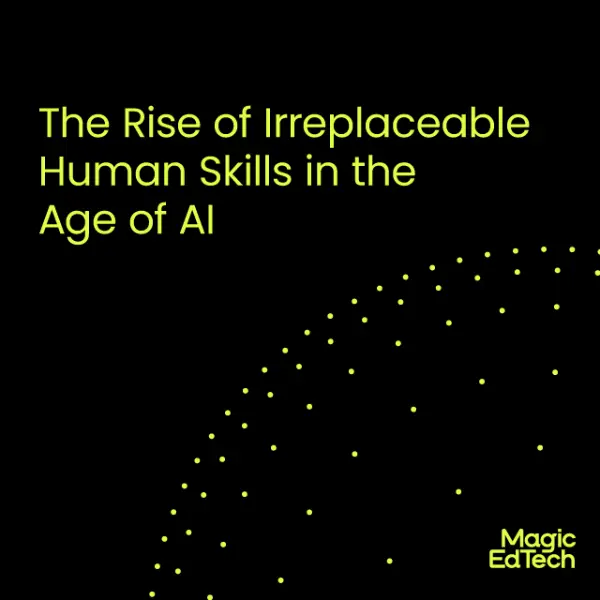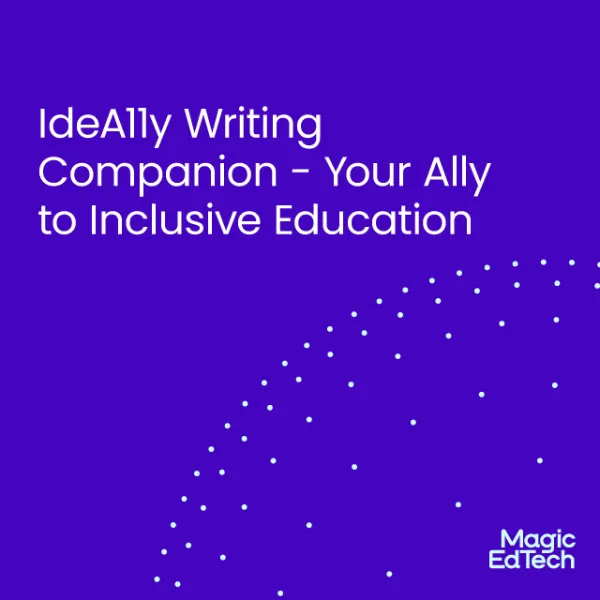The Symbiotic Dance of AI and Pedagogical Effectiveness
- 8 November, 2023
- Reading Time: 4 mins
We find ourselves in the midst of a profound transformation in education being orchestrated by artificial intelligence (AI). From the humble origins of video cassette players to contemporary AI tools, education has undergone a complete metamorphosis. Yet, amid this revolution is the truth that the essence of learning remains steadfast, and the role of educators and teachers remains as pivotal as ever. Acky Kamdar, CEO of Magic EdTech was recently named a panelist at the AI+EDU Conference, hosted by EdTech Insider. The session, led by Alex Sarlin, Co-Founder of EdTech Insiders, other panelists included Dr. Deepak Sekar, CEO and Co-Founder of Prof Jim, Younes Mourri, Founder & CEO at LiveTech.AI, Hanna Celina, Co-Founder & CPO at Kinnu, and Gautam Thapar, CEO at Enlighten AI. Below are some insights from the conversation pertaining to AI-generated learning, its effectiveness, and the real-world applicability of this emerging technology.
The AI-Led Transformation of Learning Content
As we move from the analog to the digital, the way we create educational content has got to evolve. AI tools have recently begun to lend their hands to accelerate the creative process. For starters, it minimizes the need for laborious editing and iterations among educators and designers. Thus expediting content creation by negating the repetitive and mundane aspects of this task.
The Democratization of Content Creation
But by far, its multilingual translation capabilities hold the most promise in content creation. AI increasingly plays a role in translating educational courses into an array of languages, including those considered low-resource, and tailoring content to cater to local nuances. As content generation becomes more accessible, the possibilities for adaptation and variation multiply. The ability to meet people at local levels, speaking to specific regions, languages, and demographics, emerges as a compelling possibility. The democratization of content creation is on the horizon, allowing individuals and organizations to build learning materials with ease. The true power of AI lies in its ability to adapt content to suit diverse learners and demographics, thus personalizing the learning experience.
Marrying Fast-Paced with Effectiveness
And thus the question arises: Can AI muster up high-quality content that changes learning outcomes for the positive? Essentially, how can we ensure it passes the litmus test of pedagogical efficacy?
The effectiveness of learning content hinges upon its alignment with research-backed instructional best practices. These practices should stand as the bedrock upon which AI-generated learning content must be built. Content creators must provide a vital compass for the AI’s course by articulating clear learning objectives that align with educational goals and the curriculum. The pedagogical effectiveness of it all comes from a feedback oasis where educators and learners continually refine the AI model with their essential insights. Multimedia elements and assessment tools leak clues to learners’ needs in the form of content analytics and cognitive analytics. All this data combined with pedagogical and ethical guidelines can improve the efficacy of AI-generated learning content at scale.
Presenting AI to Educators
The second consideration delves into the practical domain – can schools seamlessly integrate this content into their existing ecosystem? Or does it necessitate a significant overhaul, demanding time and resources that schools don’t have? How do teachers, students, and other stakeholders perceive and interact with the content? Does it align with their expectations, and will it yield the intended results?
Introducing AI to school leaders, often apprehensive of its implications, is a daunting task. To quell their fears, we must illuminate the transformative capabilities of AI using demonstrable data on student success. Educators can be won over when AI tools are presented as pragmatic instruments that can be woven into the classroom fabric seamlessly.
It is a challenge to command excitement for AI in a mere half-hour presentation. Still, we are armed with the tools that can kindle their curiosity:
- Chat GPT: A digital conversationalist, illustrating the delightful unpredictability of AI with its creative responses and engaging features.
- Artistic AI: The artistry of AI, painting captivating visual content, ranging from artwork to informative infographics.
- Pickaxe Tool: Empowering teachers to create their mini chatbots, addressing specific classroom challenges with autonomy.
- Chat GPT Plugins: If accessible, unveiling the potential of Chat GPT plugins, expanding its repertoire to tasks like slide deck generation or document evaluation.
Above everything, they will only accept AI-based tools if they can pivot toward a more strategic role and if it empowers them to adapt content to meet the unique needs of diverse learners. So we conclude with three important tips: demonstrate the power of AI tools in creating engaging and enjoyable learning experiences for students; offer high-quality AI tools that are readily accessible; and finish your presentation with a useful tool that can enhance their teaching methods immediately.
Education is a human-centered endeavor and AI and pedagogy are not adversaries but collaborators. For edtech companies, carving a unique identity within this expansive AI-driven content creation landscape is a coveted prize. AI tools must prove pedagogical soundness, practicality, and the lived experiences of those engaging with the content. It is not merely about constructing content; it is about creating experiences that resonate with students.




